Cubase SX step by step - Plug-ins

This article was first written for Musicrun. It is reproduced here with their kind permission...
Plug-ins
The fact that our sequencers' architecture is opened to third-party developers has considerably changed the vision we could have of a piece of software. Remember: a plug-in is a piece of software which works inside a "host" program in order to give it possibilities it does not have initially, or to imrpove some of its functions. It is thus possible to add Cubase capacities which are only limited by their creators' imagination...
How to install VST plug-ins
As well for effects as for VST-is, on the PC platform, we will distinguish two different technologies. On one hand, there are VST plug-ins which use Steinberg's protocol. These plug-ins can be used in any VST compatible applicatin, and there are many of them! On the other hand, there is the DirectX protocol which has been created by Microsoft. Basically, these are "functions" included in the OS and which can be used by programmers without having to worry about which host will use them, provided that it is DirectX compatible. Finally, once installed, VST or DirectX, their use in Cubase will be the same, except for a subtle tinge.
Devices menu, Plug-in Information option, we will choose a shared folder in
which VST Plug-ins will be installed we will want to use in other VST applications. Generally
we chose the folder C:\Program Files\Steinberg\Vstplugins. |
Be careful, this implies that the programs placed in C:\Program Files\Steinberg\Cubase SX\Vstplugins
will be visible and usable only by Cubase SX. But don't worry, in case of error of strategy
during the installation, we will be able to correct it. See below. |
It is a good thing to organize in order to find things easier later. Create subfolders in the two
Vstplugins folders, for example Reverb, EQ., Misc., Mastering, etc. The Effects Rack pop-up menu
will open according to this classification. |
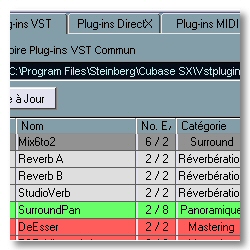 |
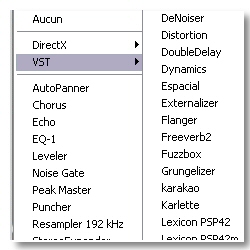 |
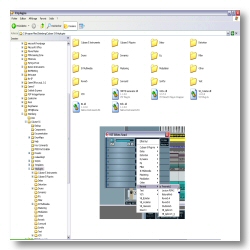 |
If the plug-in is bundled as a DLL file, you just have to copy it in one of the Vstplugins
folders. You decide if it will only be used in CUbase or in another VST application installed on the
computer. Simple. |
If the plug-in is bundled with an installation program, there can be two possibilities : either the
installation lets you chose the destination directory, or it will placec the DLL file in
c:\Program FIles\Steinberg\Vstplugins by default without asking your opinion. |
If the DLL file has been placed in a directory which does not fit you, it is possible to move it
whenever you want, Cubase will take this change into account the next time it will start.
Conclusion : do not worry about DLL files, nothing is irreparable! |
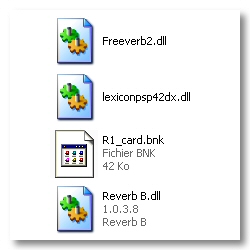 |
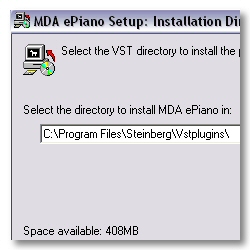 |
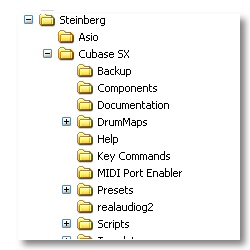 |
How to install DirectX plug-ins
LIt is not exactly the same method. Actually, a DirectX plug-in does not install itself in Steinberg's directories, but in a directory of its own, generally in C:\Program Files. It is then registered in the Registry and DirectX compatible programs will recognize it by this way. If the installation procedure lets you chose the installation directory, it will not be very useful concerning Cubase. And this is the bad news I told you in the introduction: it is impossible to organize DirectX plug-ins in Cubase SX as we saw it concerning VST plug-ins. This is thus one of the demands made by users to Steinberg...
So, to install a DirectX plug-in, you just have to click on the *.exe file which is bundled and to follow
the step by step procedure on the screen. in my opinion, it is useless to modify the installation folder,
and rather let the default installation unfold. |
A word about protections this article cannot take into account all the processes invented by editors to
protect their programs, even for 48 hours. A key, a serial number, or an On-line registration, refer to
the manual. |
Let's return to Cubase. Devices / Plug-ins information menu, it is possible here to inactivate VST
or DirectX plug-ins in order they do not appear in the racks. It is useless indeed to have DirectX effects
if a VST version is also installed, which is often the case.
|
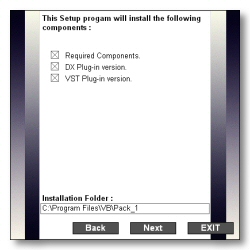 |
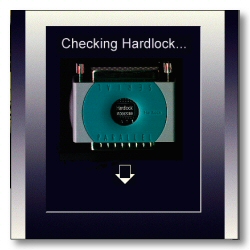 |
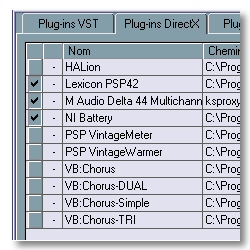 |
Regarding DirectX, this method allows to make disappear from racks some incongruous elements installed by
other programs, but which Cubase cannot use. We do not really know of it does free up ressources, but it
will avoid Cubasian insults as this one: |
PTo uninstall a plug-in, it is simple. If it is a VST plug-in, just suppress the DLL file! For DirectX ones,
use the uninstall procedure as for any program. If a DirectX refuses to uninstall, download Vincent Burel's
DX PLug-in Uninstaller on www.vb-audio.com ! |
A word about VST-is. Cubase only knows VST 2 format. These programs installed themselves as a VST plug-in,
and the DLL file can be placed in the folder you want. As far as I am concerned, I use one directory dedicated
to VST-is. Tidy your room! ,o) |
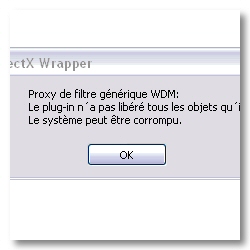 |
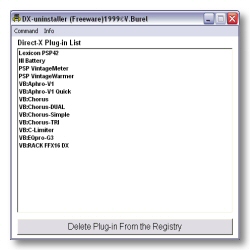 |
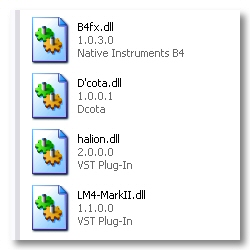 |
If you want to learn more about VST-is and if you understand French, you can read Pierre-Yves Bessuand's book
called "Plug-ins Vol.1 - Les instruments virtuels" edited by Musicrun ! www.musicrun-editions.com |
Be careful! It is obvious taht each plug-in will use processor and memory ressources of your computer. Some
of them can even use all the ressources available. Keep an eye on the "VST Performance"... and make choices. Or export
the track (see Cubase SX step by step #1) |
UOnce installed, these inserts are available in the effects racks, well organized for VST ones, in a messy way for
DirectX. So it is high time to go to the next step: the use in itself, insert, aux send, master, VST-is...
How lucky we are! |
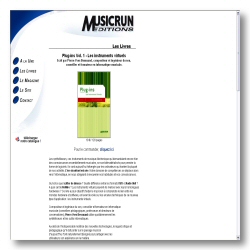 |
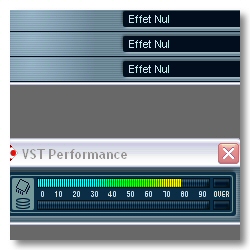 |
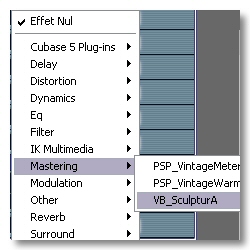 |
How to use plug-ins
We have to distinguish three types of use. The auxilliary send. In this configuration, the processed signal is mixed with the original non-processed signal. In insert, only the processed signal will be heard. Then, the Master effect, a kind of global insert, which will affect the whole mix. So, insert or aux? Even if transgressing the pre-established rules can give interesting results, we will use in aux reverbs or delays for example, whereas we will use in insert or as Master effects dynamic effects such as compression or EQs. Concerning modulation effects such as Chorus/Flanger, I would say it depends on what we want to get...
Auxilliary effects and Master have to be loaded in their own racks. If some plug-ins are invisible in the Master rack,
that is because they are mono and cannot be used here. Insert effects havec to be directly loaded in the Mixer, track by
track. |
Master effects have to be loaded in the right rack, they are immediately active. The difference between the six first
and the two last slots os that they are respectively pre and post master. We will use in post master mainly the Dithering
treatments. |
As far as Inserts are concerned, they are directly loaded in the mixer, on the track you want. We can reach it either
by the Mixer, or through the Channel Settings, or else directly in the Inspector. Click in a fre slot and load
the plug-in you want.
|
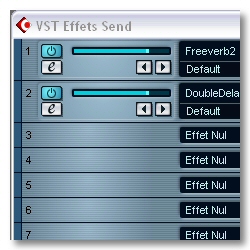 |
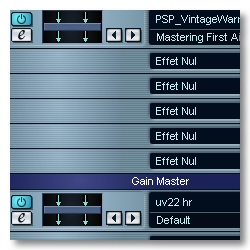 |
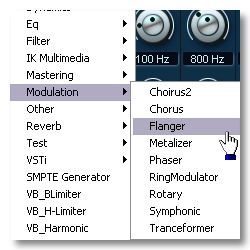 |
For these two types of effects, there is no input/output levels (as I said above only the processed signal can be heard)
except if the plug-in itself has this kind of settings. If you want to measure out a Chorus effect, you will have to use
an auxilliary effect. |
Concerning auxilliary effects, you can reach them through the Inspector, the MIxer or the Channel Settings. But you will
have to load an effect in the rack (F6) before. To know these three ways to reach them allows to gain time by loading the
plug-ins from the nearest point ,o) |
What about MIDI? You can go to the Cubase SX step by step #1. We saw that MIDI was
not audio and that we cannot apply an audio effect, except if the track pilots a VST-i. A purely MIDI track has to be
converted into Audio first! |
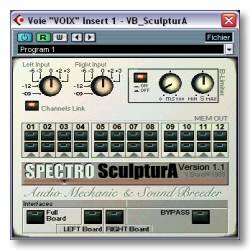 |
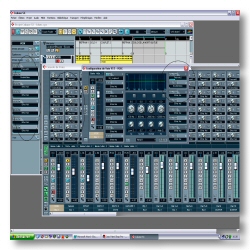 |
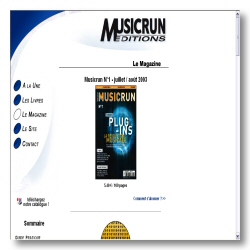 |
But... but... Cubase SX proposes MIDI effects! These plug-ins can be loaded in insert on a MIDI track. Once again, I insist
on the fact that this is not an Audio process, these plug-ins modify MIDI data on the fly. |
VST-is. They produce Audio and are piloted by MIDI. These plug-ins are simple to load. Call the VST-i rack by pressing F11. If
you followed my advice, your VST-is are well organized - the time you gain is enormous when you do not have to search for
things! |
In the Project, you just have to add a MIDI track, and to attribute it your interface in input, and the VST-i in
output. But there are exceptions, a program like Groove Agent can be used as a MIDI in to go to another VST-i or an
expander... See ya, here or elsewhere ,o)
|
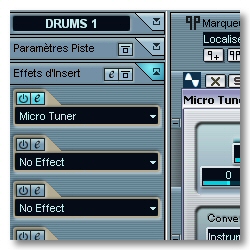 |
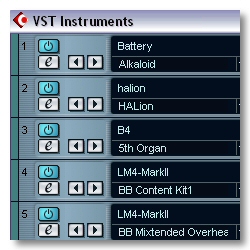 |
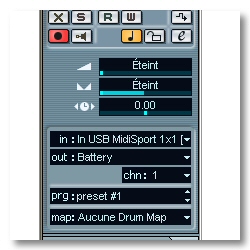 |





